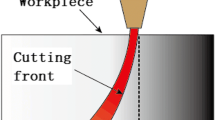Abstract
In the process of abrasive water jet cutting, the change of nozzle diameter, due to nozzle wearing throughout cutting process, causes a decrease in surface quality and an increase in kerf width. In this paper, a series of experiments have been done to determine the effect of process parameters and the results show that traverse speed and nozzle diameter are significant parameters on the kerf quality and geometry, and a control program algorithm is suggested to compensate the effect of nozzle diameter increase on cut surface quality and kerf width and the control program creates an offset with required amount in nozzle path.
Similar content being viewed by others
References
Hashish M (1988) Visualization of the abrasive waterjet cutting process. Experim Mech 28/2:159–169
Brissaud BD, Junkar M (2004) Monitoring of abrasive water jet (AWJ) cutting using sound detection. Int J Adv Manuf Technol 24:733–737
Nanduri M, Taggart DG, Kim TJ (2000) A study of nozzle wear in abrasive entrained water jetting environment. Journal of Tribology 122:465–471
Nanduri M, Taggart DG, Kim TJ (1999) Cutting efficiency of abrasive waterjet nozzles. 10th American Waterjet Conference, paper 15
Nanduri M, Taggart DG, Kim TJ (2002) The effects of system and geometric parameters on abrasive water jet nozzle wear. Int J Mach Tools Manuf 42:615–623
Mort GA (1991) Long life abrasive water jet nozzles and their effect on AWJ cutting. 6th American Water Jet Conference 315–344
Kovacevi R (1992) Monitoring the depth of abrasive waterjet penetration. Int J Mach Tools Manufact 32(5):725–736
Hloch S, Valíček J (2009) Focusing tube wear influence on surface quality at abrasive waterjet cutting. Mach Techn Maters 3(11–12):18–20
Jegaraj JR, Babu NR (2007) A soft computing approach for controlling the quality of cut with abrasive waterjet cutting system experiencing orifice and focusing tube wear. J Mater Process Technol 185:217–227
Orbanic H, Junkar M (2008) Analysis of striation formation mechanism in abrasive water jet cutting. Wear 265:821–830
Magyari A, Ilias N, Radu S, Magyari AA (1999) The influence of rocks parameters during the cutting. 10th American Waterjet Conference, 35
El-Domiaty AA, Abdel-Rahman AA (1997) Fracture mechanics-based model of abrasive waterjet cutting for brittle materials. Int J Adv Manuf Technol 13:172–181
Laurinat A, Louis H, Wiechert GM (1993) A model for milling with abrasive water jet. 7th American Water Jet Conference, 119–139
Guo NS, Louis H, Meier G (1993) Surface structure and kerf geometry in abrasive water jet cutting: formation and optimization. 7th American Water Jet Conference, 1–25
Azmir MA, Ahsan AK (2009) A study of abrasive water jet machining process on glass/epoxy composite laminate. J Mater Process Technol 209:6168–6617
Shanmugama DK, Masoodb SH (2009) An investigation on kerf characteristics in abrasive waterjet cutting of layered composites. J Mater Process Technol 209:3887–3893
El-Domiaty AA, Shabara MA, Abdel-Rahman AA, AI-Sabeeh AK (1996) On the modelling of abrasive waterjet cutting. Int J Adv Manuf Technol 12:255–265
Kulekci MK (2002) Processes and apparatus developments in industrial waterjet applications. Int J Mach Tools Manuf 42:1297–1306
Chetty OVK, Babu NR (1999) Some investigations on abrasives in abrasive waerjet machining. 10th American Waterjet Conference, paper 30
Benyounis KY, Olabi AG, Hashmi MSJ (2008) Multi-response optimization of CO2 laser-welding process of austenitic stainless steel. Optics Laser Technol 40:76–87
Montgomery DC (2008) Design and analysis of experiments, 7th edn. Wiley, New York
Lin BT, Jean DM, Chou JH (2007) Using response surface methodology for optimizing deposited partially stabilized zirkonia in plasma spraying. Appl Surf Sci 253:3254–3262
Shanmugam DK, Wang J, Liu H (2008) Minimisation of kerf tapers in abrasive waterjet machining of alumina ceramics using a compensation technique. Int J Mach Tools Manuf 48:1527–1534
Chalmers EJ (1991) Effect of parameter selection on abrasive waterjet performance. Proceedings of 6th American Waterjet Conference, 345–354
Jegaraj JJR, Babu NR (2003) Fuzzy based control strategy for condition monitoring of abrasive waterjet using vacuum sensor. Proceedings of the International Conference on Leading Edge Manufacturing in 21st Century, 1039–1046
Caydas U, Hascalık A (2008) A study on surface roughness in abrasive waterjet machining process using artificial neural networks and regression analysis method. J Mater Process Technol 202:574–582
Srinivasu DS, Babu NR (2008) A neuro-genetic approach for selection of process parameters in abrasive waterjet cutting considering variation in diameter of focusing nozzle. Appl Soft Comput 8:809–819
Valicek J, Holoch S (2010) Using the acoustic sound pressure level for quality prediction of surfaces created by abrasive waterjet. Int J Adv Manuf Technol 48(1–4):193–203
Lebar A, Junkar M, Poredos A, Cvjeticanin M (2010) Method for online quality monitoring of AWJ cutting by infrared thermography. CIRP J Manuf Sci Technol 2:170–175
Orbanic H, Junkar M, Bajsic I, Lebar A (2009) An instrument for measuring abrasive water jet diameter. Int J Mach Tools Manuf 49:843–849
Author information
Authors and Affiliations
Corresponding author
Rights and permissions
About this article
Cite this article
Zohoor, M., Nourian, S.H. Development of an algorithm for optimum control process to compensate the nozzle wear effect in cutting the hard and tough material using abrasive water jet cutting process. Int J Adv Manuf Technol 61, 1019–1028 (2012). https://doi.org/10.1007/s00170-011-3761-0
Received:
Accepted:
Published:
Issue Date:
DOI: https://doi.org/10.1007/s00170-011-3761-0




